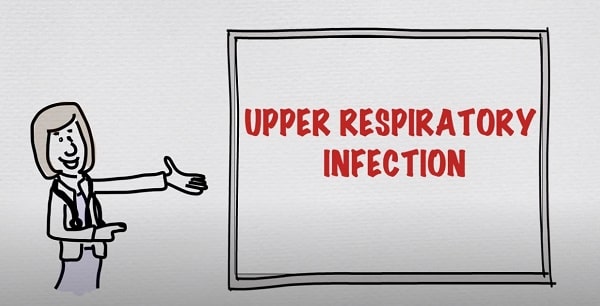Upper Respiratory Infections

The upper respiratory tract infections involve the infection and inflammation in the respiratory mucosa starting from the nose to the lower respiratory tract but not including the alveoli.
These are mostly due to viral origin. However, it is important to differentiate them from the bacterial origin and super infections as they need other therapy forms to counteract them.
The upper respiratory tract includes the sinuses, nasal passages, pharynx, and larynx.
Inflammatory diseases of the upper respiratory tract include:
- Rhinitis
- Sinusitis
- Adenoiditis
- Tonsillitis
- Tonsillitis
- Laryngitis
- Pharyngitis
Most upper respiratory infections will get better within the course of a few days or a week. Sometimes, they can linger on and last as much as three weeks, causing severe coughing and other symptoms.
These upper respiratory infections include the common cold, the flu, a sore throat, bronchitis, sinusitis, and ear infections. And we now know that the vast majority of these infections are viruses and will get better on their own.
However, it also means that antibiotics won’t help improve these infections the vast majority of the time.
What Is The Best Antibiotic For Upper Respiratory Infections?
Amoxil (Amoxicillin) is the first choice antibiotic to treat upper respiratory infections. It is broad-spectrum semi-synthetic penicillin.
The maximum daily amount of Amoxicillin is 3000 mg. Typically, the antibiotic is taken three times a day at eight-hour intervals for up to 10 days. Take the drug before or after your meals.
You need to have a prescription to buy Amoxicillin in the US, Canada, or Europe. The price of brand Amoxil in the US is around $10-12 depending on a pharmacy.
More about Amoxicillin in this video:
When Should You Take Antibiotics?
Of course, when your physician or provider prescribes them and recommends them for you.
Antibiotics are prescribed for inflammatory diseases caused by bacteria if there is a high risk of complications.
Viruses more often cause rhinitis and laryngitis, while sinusitis, angina, and otitis are of bacterial origin.
Your doctor will prescribe you antibiotics only if bacteria cause the disease.
A physician rarely prescribes antibiotics to treat merely cold. It is acceptable only in cases when the immune system cannot fight the pathogens on its own.
Antibiotics are a must if the flu or respiratory infection contributed to the development of purulent angina, acute bronchitis, or pneumonia.
Antibiotic medications definitely have a place and can treat some of these infections. But they also have potential side effects.
The side effects may be:
- minor rash;
- irritation;
- diarrhea.
That’s a relatively common side effect of antibiotics. However, they can be much more severe and, in rare cases, even life-threatening.
We are not trying to scare you not to take antibiotics when you need them, but when you don’t need them.
Bacterial Resistance
We do know that there is a big problem with taking unnecessary antibiotics. The issue is that bacteria are becoming more and more resistant to this kind of drug.
There are now some bacteria that are entirely resistant to every known antibiotic. That is why very strong combinations of antibiotics must be used to treat those bacterial infections.
We want to minimize that problem. Unfortunately, a big part of that problem is taking antibiotics when you don’t need them.
However, if you do get a prescription for antibiotics, take the full complete treatment course to minimize the chance that some bacteria will not be killed by the antibiotic and might then be resistant to that antibiotic in the future.
Antibacterial medications are important when you need them. But they do not help for the vast majority of respiratory infections and can cause problems.
Facts About Antibiotics You Should Know
Although some people are sure that you can treat almost anything with antibiotics, it is not true.
Moreover, doctors do not always prescribe them to treat cold.
It is definitely not possible to treat flu and colds caused by viruses with antibiotics. The effect of antibacterial drugs in such cases will not be sufficient enough.
All viral infections should be treated only with antiviral drugs. They are prescribed not only for the treatment but also for preventing SARS (Severe acute respiratory syndrome).
When Do Adults Need Antibiotics For Upper Respiratory Infection?
First of all, a doctor can prescribe you an antibiotic when a bacterial infection re-joins the viral infection.
Such complications may lead to:
- sore throat;
- acute bronchitis;
- laryngotracheitis;
- pneumonia.
In the cases mentioned above, doctors may prescribe antibiotics like Amoxil, Clarithromycin, Azithromycin.
Here are the symptoms when your physician may prescribe taking antibiotics in case of upper respiratory infection:
- pain while swallowing;
- inflammation;
- shooting pain in the ears;
- enlarged lymph nodes in the neck and under the jaw;
- fever over 102 degrees;
- chest pain;
- watery eyes;
- conjunctivitis.
Before prescribing such medications, the doctor should carefully examine the patient, possibly referring for additional examinations.
The duration of treatment with antibiotics is usually five or seven days depending on the disease’s severity.

